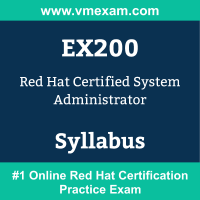 The Red Hat EX200 exam preparation guide is designed to provide candidates with necessary information about the RHCSA exam. It includes exam summary, sample questions, practice test, objectives and ways to interpret the exam objectives to enable candidates to assess the types of questions-answers that may be asked during the Red Hat Certified System Administrator (RHCSA) exam.
The Red Hat EX200 exam preparation guide is designed to provide candidates with necessary information about the RHCSA exam. It includes exam summary, sample questions, practice test, objectives and ways to interpret the exam objectives to enable candidates to assess the types of questions-answers that may be asked during the Red Hat Certified System Administrator (RHCSA) exam.
It is recommended for all the candidates to refer the EX200 objectives and sample questions provided in this preparation guide. The Red Hat RHCSA certification is mainly targeted to the candidates who want to build their career in Linux Administrator domain and demonstrate their expertise. We suggest you to use practice exam listed in this cert guide to get used to with exam environment and identify the knowledge areas where you need more work prior to taking the actual Red Hat Certified System Administrator exam.
Red Hat EX200 Exam Summary:
|
Exam Name
|
Red Hat Certified System Administrator (RHCSA) |
| Exam Code | EX200 |
| Exam Price | $400 USD |
| Duration | 150 minutes |
| Number of Questions | 20 |
| Passing Score | 210 / 300 |
| Recommended Training / Books |
Red Hat System Administration I (RH124) Red Hat System Administration II (RH134) RHCSA Rapid Track Course (RH199) |
| Schedule Exam | PEARSON VUE |
| Sample Questions | Red Hat EX200 Sample Questions |
| Recommended Practice | Red Hat Certified System Administrator (RHCSA) Practice Test |
Red Hat RHCSA Syllabus:
| Section | Objectives |
|---|---|
| Understand and use essential tools |
- Access a shell prompt and issue commands with correct syntax - Use input-output redirection (>, >>, |, 2>, etc.) - Use grep and regular expressions to analyze text - Access remote systems using SSH - Log in and switch users in multiuser targets - Archive, compress, unpack, and uncompress files using tar, gzip, and bzip2 - Create and edit text files - Create, delete, copy, and move files and directories - Create hard and soft links - List, set, and change standard ugo/rwx permissions - Locate, read, and use system documentation including man, info, and files in /usr/share/doc |
| Manage software |
- Configure access to RPM repositories - Install and remove RPM software packages - Configure access to Flatpak repositories - Install and remove Flatpak software packages |
| Create simple shell scripts |
- Conditionally execute code (use of: if, test, [], etc.) - Use Looping constructs (for, etc.) to process file, command line input - Process script inputs ($1, $2, etc.) - Processing output of shell commands within a script |
| Operate running systems |
- Boot, reboot, and shut down a system normally - Boot systems into different targets manually - Interrupt the boot process in order to gain access to a system - Identify CPU/memory intensive processes and kill processes - Adjust process scheduling - Manage tuning profiles - Locate and interpret system log files and journals - Preserve system journals - Start, stop, and check the status of network services - Securely transfer files between systems |
| Configure local storage |
- List, create, delete partitions on MBR and GPT disks - Create and remove physical volumes - Assign physical volumes to volume groups - Create and delete logical volumes - Configure systems to mount file systems at boot by universally unique ID (UUID) or label - Add new partitions and logical volumes, and swap to a system non-destructively |
| Create and configure file systems |
- Create, mount, unmount, and use vfat, ext4, and xfs file systems - Mount and unmount network file systems using NFS - Configure autofs - Extend existing logical volumes - Create and configure set-GID directories for collaboration - Diagnose and correct file permission problems |
| Deploy, configure, and maintain systems |
- Schedule tasks using at and cron - Start and stop services and configure services to start automatically at boot - Configure systems to boot into a specific target automatically - Configure time service clients - Install and update software packages from Red Hat Content Delivery Network, a remote repository, or from the local file system - Modify the system bootloader |
| Manage basic networking |
- Configure IPv4 and IPv6 addresses - Configure hostname resolution - Configure network services to start automatically at boot - Restrict network access using firewalld and firewall-cmd |
| Manage users and groups |
- Create, delete, and modify local user accounts - Change passwords and adjust password aging for local user accounts - Create, delete, and modify local groups and group memberships - Configure superuser access |
| Manage security |
- Configure firewall settings using firewall-cmd/firewalld - Manage default file permissions - Configure key-based authentication for SSH - Set enforcing and permissive modes for SELinux - List and identify SELinux file and process context - Restore default file contexts - Manage SELinux port labels - Use boolean settings to modify system SELinux settings |
